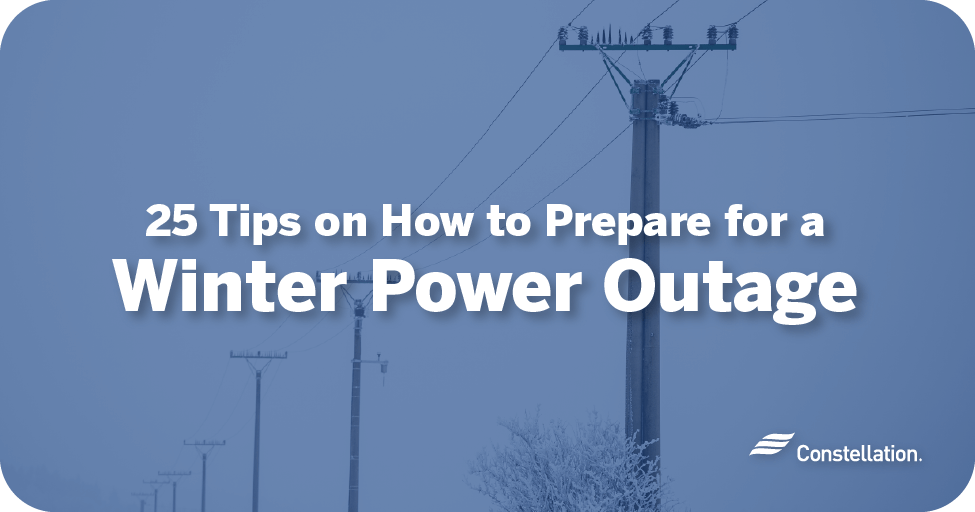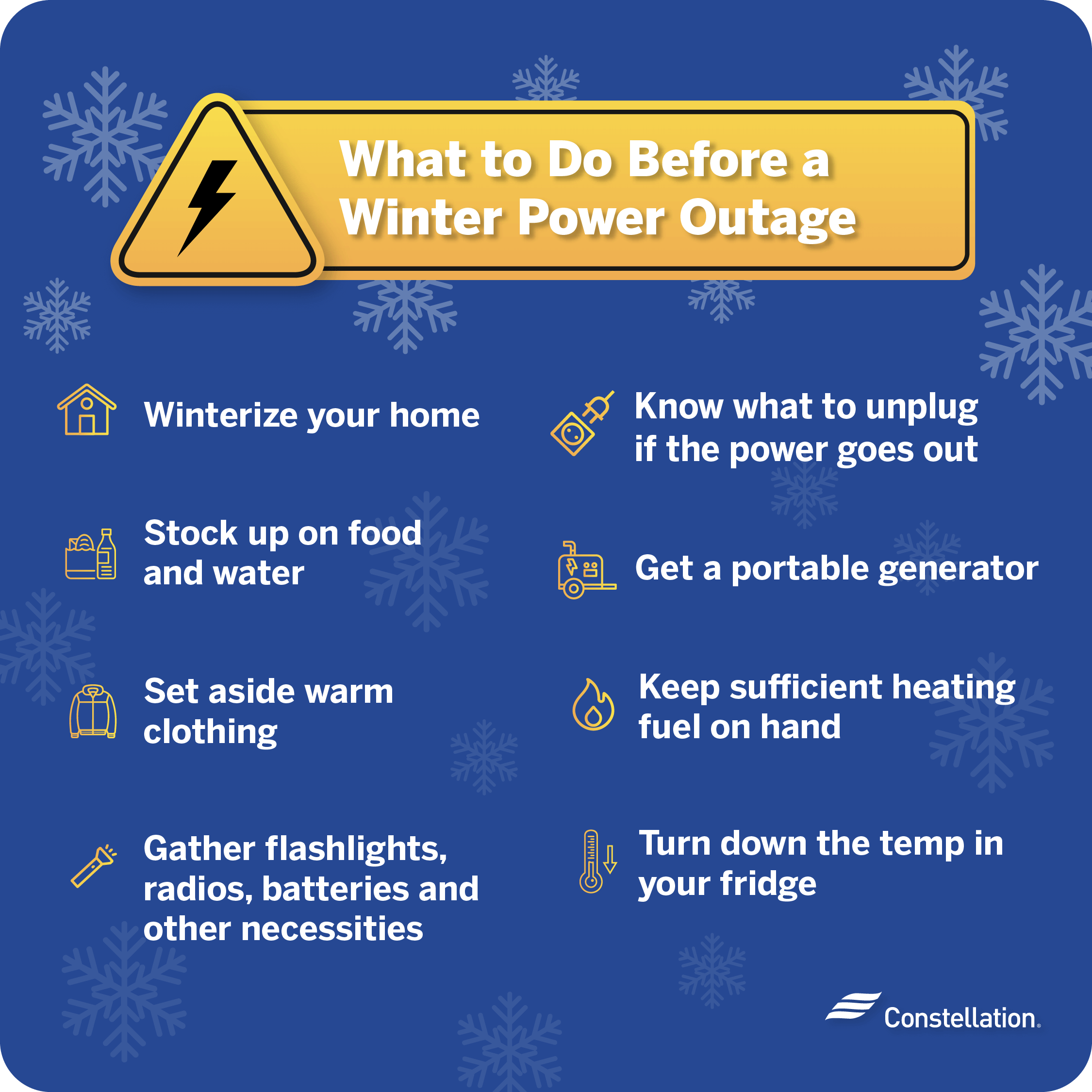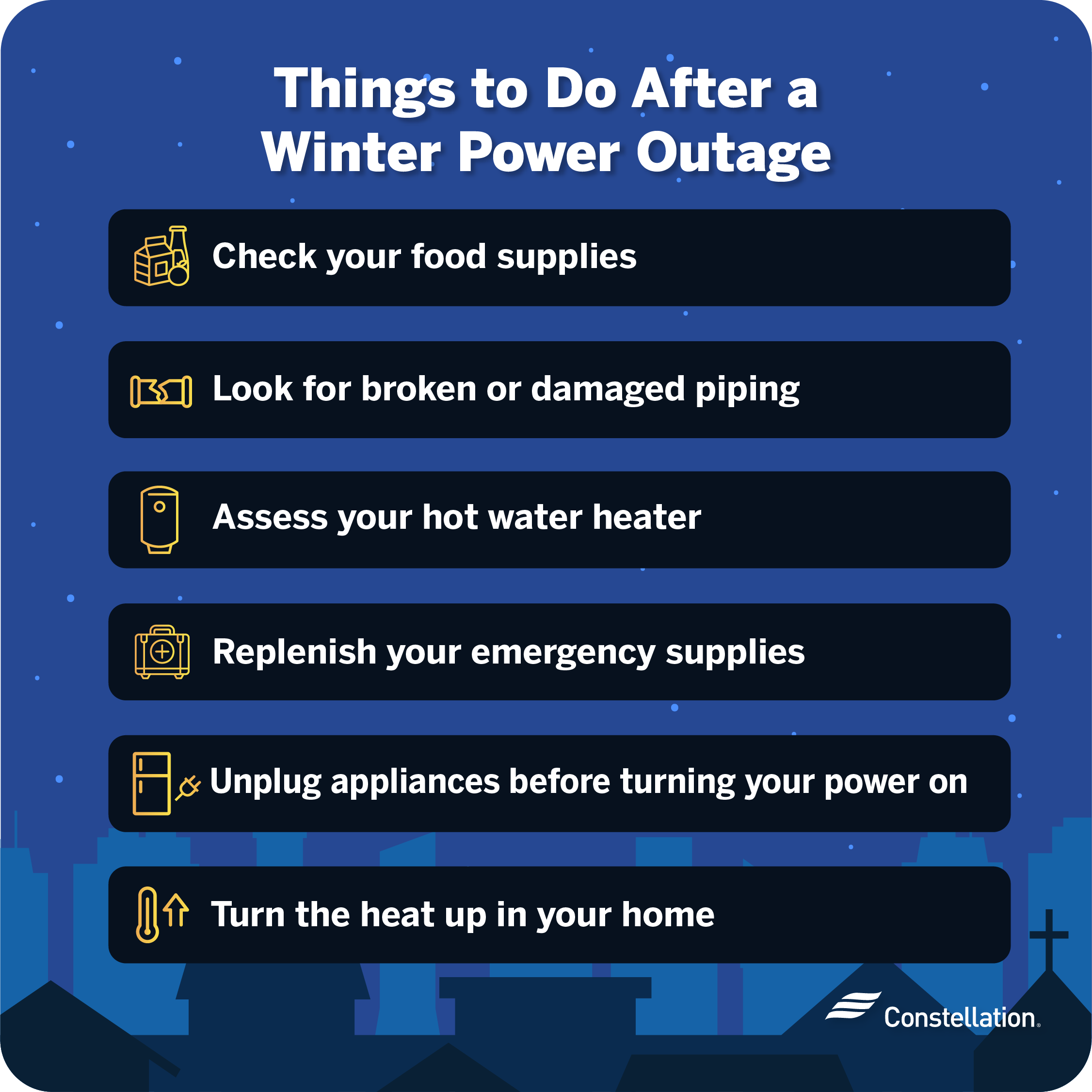
- Category:
Disaster Preparedness -
Last updated:
November 16, 2023
25 Tips on How to Prepare for & What to Do During a Power Outage in the Winter
Many of us know how important it is to be prepared for a winter power outage. Heavy snow, sleet, ice and wind can wreak havoc on power lines. And when the electricity goes out, so does the furnace or boiler. But there are ways to keep the situation from becoming a true emergency by learning how to prepare for a winter power outage.
Here, we’ve got your power outage survival guide to teach you how to prepare for and what to do during a winter power outage. Read on to find tips for what to do before a winter power outage, during the event and after electricity is restored.
What to do before a winter power outage

Knowing what to do if power goes out in winter will make a winter storm power outage less disruptive and protects your home and family. These tips and preparations will make sure you are ready for whatever the weather brings.
1. Winterize your home
Depending on how you heat your home, a winter power outage has the potential to make your home uncomfortable and puts systems at risk of freezing. Most systems rely completely or in part on electricity, even gas and oil systems. It’s important to make sure your house can hold in as much of its heat as possible. Take the time to weatherize your home for winter before the cold weather hits.
Preparing for winter storm power outages by weatherizing your house can include easy, affordable steps like weatherstripping around doors and windows or adding draft guards. Drafty doors and windows can lead to higher energy costs. Take the time to search your home for air leaks and seal them more permanently.
Bigger projects, like adding insulation to your attic and walls or upgrading your entryway with an energy-efficient door are methods for how to prepare for a power outage in winter, and also help you potentially save on your heating bill all season.
There’s a difference between a brownout and a blackout, but it is important that your house has the ability to efficiently retain heat without power, whether for short or long periods.
How to prevent pipes from freezing in a power outage
When water freezes, it expands. Water that freezes in your pipes can burst, leading to major damage. Property damage from burst water pipes can cost thousands of dollars to fix. Protecting pipes, therefore, is high on the list for how to prepare for a power outage in winter.
The pipes most at risk of freezing are those without insulation running through unheated spaces. Also, pay special attention to pipes in cabinets or in outside-facing walls. Insulating pipes ahead of time is perhaps the best method to prevent them from freezing during a power outage.
If you haven’t insulated your pipes, you can take steps to protect them during a winter power outage. Open up cabinet doors under sinks in your kitchen and bathrooms to let warm air in. Let water trickle through faucets, as moving water does not freeze as fast.
2. Stock up on food and water
Food and drinkable water should rank at the top of your winter storm necessities. In a long-term power outage, the food in your refrigerator and freezer will only last as long as those appliances keep them cold enough not to spoil.
Stock up on shelf-stable foods and bottled water, in case there’s a problem with the tap water or you have an electric water pump. Plan on a gallon of drinking water per person per day, with additional water for washing and cooking. Stock freeze dried and canned goods, cereals and rice, powdered milk and instant coffee, nuts and dried fruits are all good options.
Prepare for a power outage in winter by having an alternative way to cook. Camping stoves, outdoor grills, and cooking in the fireplace are options.
3. Set aside warm clothing
It’s natural to worry about how to heat your home when the power goes out in winter. But there are ways to stay warm other than starting a fire in your fireplace or wood stove.
Wearing several layers of clothes, especially starting with insulated long underwear, is a great way to hold on to body heat. If you know a winter storm is coming, set aside warm clothes where you and your family can easily get to them. Make sure to include hats and gloves, warm socks, sweaters, coats and boots.
4. Gather flashlights, radios, batteries and other necessities
It’s easy to take electric power for granted — until the lights go out. Make sure you have all the batteries you need to power your electric winter storm necessities. You can also get portable chargers and power banks, to keep charged and ready in case of an outage.
You’ll need flashlights or lanterns handy to be able to see at night. Battery-powered or crank radios keep you informed about emergency efforts in your area. It makes sense to keep your phone charged ahead of a winter storm.
5. Know what to unplug if the power goes out
The first thing to think about when it comes to what to do if power goes out is to protect your appliances and electronics. When the power comes back on, your home’s electrical system could experience damaging power surges. Unplug every appliance and electronic device in your house. The most vulnerable devices include:
- Desktop and laptop computers
- Televisions
- Gaming systems
- Microwaves
- Appliances with advanced technology and onboard computers (for example, some modern washers and dryers)
- All elements of your smart home
When the power comes back on, you may experience flickering light, a sign of surging power. Wait for consistent electricity to be restored before plugging in devices.
6. Get a portable generator
Having an energy-efficient portable generator as a backup is an ideal answer to the question of how to prepare for a power outage in winter. You won’t be able to power your whole house, but you could run a few appliances (like a fridge) and keep your phones charged. Even a small portable power station can make a big difference in comfort.
Most portable generators run on gasoline or propane, so you’ll need to stock up on that fuel. Keep it in a safe, well-ventilated place away from your house. And because the exhaust from a gas generator is toxic, make sure to run it at least 15 feet from any part of your home.
7. Keep sufficient heating fuel on hand
It is important to be ready and know what to do if you lose power in the winter. Portable battery systems with solar panels are a good idea. Have firewood or wood pellets ready for your fireplace. A few bottles of propane are handy for cooking outdoors or with the careful use of a camping stove. If you have a gas fireplace, consider installing a battery backup for the starter if you don’t already have one.
8. Turn down the temp in your fridge
Keeping your refrigerator cooler will help your food last longer. Minimize opening and closing the fridge door to keep cold air in longer. You may wish to store freezer packs that you can use in a cooler to extend the freshness of refrigerated items.
What to do if you do lose power in the winter
Knowing how to prepare for a power outage in winter is a first step. You should also plan ahead for what to do if power goes out this winter. These steps will keep you safe and comfortable.
9. Confirm the power outage area
Confirm if the winter power outage is just for your home or if it extends to others in your area. If you are able, sign up for weather warnings and text updates from your utility company. Report the power outage to your local utility. The information you provide could help you get your power back up quicker.
10. Avoid carbon monoxide poisoning
Carbon monoxide poisoning risks are higher during a power outage as people use alternative fuels for cooking, heating and powering devices. Keep a window cracked where you are sleeping and install a working carbon monoxide detector in every bedroom and in every room where you may have open flames.
11. Keep kids and pets safe
Pets, kids and fire do not mix. Be careful around candles or better, use battery-powered light sources. Use extra care around fireplaces and camp stoves. Keeping appliances and devices unplugged during an outage also reduces the risk of electric shock. Be mindful around downed power lines and standing water outdoors. Lastly, with smaller bodies, kids and pets get colder faster. Make sure they are bundled up, but can breathe freely.
12. Listen for updates
A battery-powered radio is invaluable in staying up-to-date about news. Take the time to sign up for your utility’s text alert system and keep your phone charged.
13. Unplug appliances
When power is restored, it may surge and flicker. Uneven power can damage expensive appliances and delicate electronic devices. Unplugging appliances to avoid damage when the power comes back on. Make sure that electric service is stable before plugging them back in.
14. Stay warm
Make sure to dress in layers to retain your body heat. Avoid exertion, as sweating can lead to severe chills. You might want to gather everyone into one room that you can keep relatively warm. Putting up a tent can be a fun and effective way to create a smaller warmer space. A 12-volt electric blanket plugged into a power pack is a way to get cozy. Turn it off to save power and stay safe before you fall asleep.
How to stay warm during a winter power outage
If you’ve prepared your home for winter well before a storm like a blizzard hits, it won’t be as disruptive and uncomfortable. Knowing how to keep your house warm without power is especially important if you go without electricity for several days. These cold-weather emergency tips can see your family through until your power is restored.
15. Condense your living space
It’s much easier to warm a smaller space than a bigger one. If you have a heat source like a fireplace or wood stove, try to close off the room where it is from the rest of the house to use fuel more efficiently. But even if you don’t have a way to burn fuel, the body heat from you and your family members will keep you warmer in a small, insulated room than in a wide-open house.
16. Keep doors to the outside closed
Generating heat is one part of what to do in a power outage in winter. Another part is holding on to that warmth. If you need to go out, shut the door behind you as soon as you pass through. Don’t linger, and never leave it open.
17. Block any drafts from entering your home
Aside from open doors, you can lose heat from gaps around and under windows and doors. You’ll want to seal those gaps as best you can, especially in the room you’re spending most of your time in. One temporary fix is to roll up towels or blankets and wedge them against the bases of doors and windows.
18. Cover windows and close blinds at night
Windows can be a major source of heat loss. When the sun goes down, cover them with heavy drapes and/or blinds to keep the room warmer. Sunlight streaming in through the panes can warm a room in winter, but if your windows are poorly insulated or drafty, you may be better off covering them.
19. Dress in multiple layers
One of your best defenses against the cold is layered clothing. Start with a warm base layer, like thermal underwear or long johns, and a pair or two of wool socks. Next add pants (insulated if you have them) and several layers of lighter, looser, warm shirts. Ideally, the outer layers should have a tight weave and be water-repellent.
And don’t forget that people lose a lot of heat through their hands, feet and head. You’ll want a warm hat and mittens, which hold heat better than gloves, as well as warm boots. Top with a coat.
Things to do after a winter power outage

It’s tempting to sit back in relief once the power comes back on. But just like you need to know how to prepare for a winter power outage, you must also know what to do when power is restored.
20. Check your food supplies
If food has been sitting at a temperature of 40 degrees Fahrenheit or higher for two hours or longer, you should toss it according to Ready.gov. Examine items in your refrigerator and freezer for signs of spoilage, such as unusual texture, color or smells. If you’re not sure if your food has gone bad, don’t risk it; just throw it out.
Take note of medicine that needs to be refrigerated. If it’s been left out for longer than 24 hours, you may need to replace it. Call your doctor’s office for instructions on what you should do.
How long will a fridge stay cold without power?
If you keep your refrigerator shut after the power goes out, it can keep food cold enough for about four hours. Freezers can keep their temperature for up to 48 hours. Keeping your freezer full is more efficient, as the frozen items help maintain the low temperature.
21. Look for broken or damaged piping
Extreme winter weather and cold can be causes of power outages. Without central heating, some water pipes in your home can freeze in frigid temperatures. Some signs of water pipe damage are pooling water under pipes; water damage on walls, floors or ceilings; low water pressure; and faucets that don’t work at all.
If you think your pipes are frozen, turn off the water at your home’s main shut-off valve. And call a plumber right away. You may be able to thaw a frozen water pipe with warm air from a blow-dryer, starting at the faucet and working back along the pipe. Do not use this method if you’re in standing water to avoid being electrocuted. Never use an open flame to thaw pipes.
22. Assess your hot water heater
If your electric hot water heater is not working after a power outage, first check to make sure you’ve given it enough time to heat up the tank. If the electricity was out for a long time, the water will be cold and can take upwards of an hour to reheat.
If you still don’t have hot water after an hour or two, you may have another problem. It’s possible a circuit breaker tripped when the power was restored. If you flip it back on and nothing happens or if your water heater keeps tripping the breaker, you may have a bigger problem. Call a professional plumber right away.
23. Replenish your emergency supplies
Replace any winter storm necessities you used during the blackout right away. You will be ready for the next outage with nonperishable foods, bottled water and fuel for your generator and vehicles. Replace spent batteries and any damaged or non-working equipment.
24. Check unplugged appliances before turning on main power switch
If you turned off the power at the main switch to your house, double check that devices and appliances are unplugged before you turn the power back on. Plug these items back in carefully and keep an eye out for surges. It is better to go a little longer without your devices than to risk surge damage.
25. Turn the heat up
To get the temperature in your home back to normal following a winter power outage, you can turn your thermostat slightly above your normal heating temperature for a few hours.
Staying safe and comfortable during winter power outages
Knowing what to do if you lose power in the winter makes a big difference in how warm and comfortable you stay while you wait for the electricity to return. You will have peace of mind knowing that you and your family are as ready as you can be.




